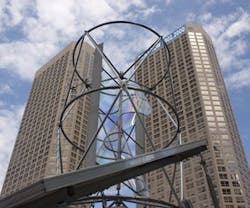Windy Cities: Rooftop Turbines Provide Economical Wind Power Continued
Variations of the Vertical-Axis Wind Turbine: Darreius and Savonious
The two predominant VAWTs – the Darreius and Savonious – differ significantly in design and performance.
The Savonious, named after Finnish engineer Sigurd J. Savonius, resembles an “S” in cross-section and is comprised of opposing curved “scoops,”. The Savonius is a drag-type turbine extracts less wind energy than the Darrieus, a lift-type assembly patented by Georges Jean Marie Darrieus, a French aeronautical engineer. The Savonious is well suited to applications that place greater emphasis on cost and reliability than efficiency. It also performs well in turbulent settings.
The Darrieus, which resembles an eggbeater, is more efficient, but prone to torque ripple and cyclic stress on the tower, conditions that can hinder reliability. Because starting torque is low, the Darrieus also requires an external power source or additional Savonius rotor to start turning.
Balanced Wind manufactures an “inverted” Darrieus whose blades pull away from the turbine structure rather than lift inward. “We did trials of hundreds of blade designs to identify the strongest performer, which happened to be a lift,” DeRosa recalls. “We also discovered we got better performance from the inverted lift than traditional inward lift, and we refined our designs from there.”
Darrieus and Savonius: Hybrid Balance
Mercy Lakefront Housing, a 96-unit, single-resident housing development in Chicago, relies on turbines that incorporate aspects of both the Darrieus and Savonius designs. Mercy's turbines, supplied by Chicago-based Aerotecture, include both Savonius (S) and Darrieus (D) rotors, the latter to increase overall RPM at high wind speeds without compromising safety and efficiency. According to Aerotecture CEO Bil Becker, “the hybrid balance of S and D rotors provides good starting torque and higher RPMs while providing a cylindrical form that is easy to integrate with a variety of building sizes, shapes and design schemes.”
The Mercy installation isn't generating the amount of wind energy engineers anticipated, according to Peter Hays, associate principal architect with Chicago-based architect Murphy Jahn, the building’s designer. The five-story structure is oriented to capture southwest winds, and it features a rounded roof edge to funnel winds from the facade to a network of horizontally mounted turbines at the roof’s center.
Specialty designs tailored to accommodate a building’s specific conditions come at a price, or even a hefty premium, because the rooftop turbine doesn't enjoy the same economies of manufacturing scale that streamlined turbines do, says Lystra.
“Cost is currently a significant barrier to entry,” agrees DeRosa, who markets a 1-kW unit for $3,500, a 5-kW unit for $18,500 and a 10-kW unit for 35,000. Assuming that production ramps up, “our goal is to drop the price of the 10-kW unit by one-third, to $20,000, in the next five to seven years,” he says.
Depending on the building’s size, owners may require several turbines to meet their objectives – a potentially significant investment, even when projected energy savings are factored into the equation.
The good news is that owners currently can obtain a 30-percent, no-cap investment tax credit from the federal government to recoup a portion of their costs. Illinois and other states provide similar incentives.
Before investing, owners do well to ensure their building and site is well suited to rooftop turbine wind energy. Although wind meters can take up to six weeks to identify prevailing conditions, new software-driven methods can significantly reduce test times.
Owners should also evaluate candidate technologies for vibration and noise. “The larger the unit, the more vibration and noise it's going to generate,” says Lystra.
The HAWT is particularly problematic, since it concentrates the majority of its weight atop a slender tower, conditions that promote vibration. VAWTs are comparatively quiet, though noise and vibration remain a challenge.
Some have likened the noise and vibration to that generated by rooftop mechanical units. However, turbine-generated vibration is more difficult to predict, and is a factor that building owners should evaluate when investigating the potential of rooftop winds and turbines.
John Gregerson is a contributing editor based in Chicago.
